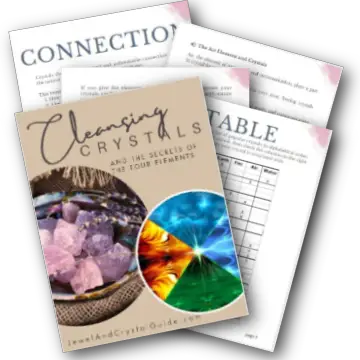Fluorite crystal comes in a wide range of colors, including purple, pink, blue, black, green, yellow, brown, and clear or colorless. So why is fluorite so many different colors?
The colors in fluorite are created by three things: minerals or impurities in the crystal, exposure to natural radiation in rocks and soil, and the environmental conditions where the crystal grows.
These influences don’t only change the color of the crystal – they also change the intensity of the hue and the range of colors within a crystal. Let’s take a look at how each factor influences fluorite’s colors and why.
In this blog post, you’ll find out:
- What factors turn fluorite different colors
- The colors they create
- Why this happens
- And how rainbow fluorite forms
Impurities give fluorite color
Most fluorite gets its color from impurities.
Fluorite crystals form when hot liquids with calcium fluoride in them seep into holes in rocks or sit on rocks. Over time, these minerals cool and grow into clear or colorless crystals.
But sometimes the hot fluids also contain other minerals that get into the growing crystal. When they do, they’re called impurities because they change the crystal’s color.
Different impurities turn the fluorite different colors, and the more impurities there are, the darker or more colorful the crystal becomes.

If you want to know how crystals get their colors, read this article next.
Below is a list of fluorite colors and the impurities that make them that color:
Clear or colorless fluorite
Clear or colorless fluorite contains few or no impurities.
Purple fluorite
The purple color of fluorite is often caused by trace amounts of manganese, which can substitute for calcium in the crystal structure.
Pink fluorite
Pink fluorite contains trace amounts of yttrium or other rare earth elements, which give the crystal a pink hue.
Rare earth elements are a group of metallic elements that are similar to each other and are often found together in nature.
Blue fluorite
Blue fluorite is colored by the impurity europium.
Black fluorite
Black fluorite contains different impurities, such as iron, carbon, and rare earth elements.
Green fluorite
Green fluorite has rare earth elements, iron, and other impurities in it.
Yellow fluorite
The yellow fluorite color is often the result of sulfur or other impurities in the growing crystal.
Want to know what each color crystal is good for? Click here for my full guide and a table.
Radiation changes fluorite’s color
Rocks with uranium, thorium, and potassium in them have a high level of natural radioactivity. And soil, which comes from rocks, has whatever radioactive materials that were in the parent rock the soil came from.
When fluorite is exposed to radiation in rocks and soil, it goes through a process called thermoluminescence. Energy gets trapped inside the crystal, almost like a battery stores energy, and stays there until the crystal is heated.
When fluorite with this stored energy gets hot, the trapped energy is released as light.
This entire process changes the crystal’s structure and how the crystal interacts with light, making it change color. And the new color depends on what type of radiation it was exposed to and for how long.
Want to know how different types of radiation affect the color of fluorite? Well …
- Alpha radiation turns fluorite yellow
- Beta radiation turns fluorite green or blue
- Gamma radiation makes fluorite green, blue, or black
Environmental conditions affect fluorite’s color
The conditions under which fluorite forms also affect its color.
Three environmental conditions that have the greatest impact on the crystal’s color are:
Natural light
Fluorite that forms in natural light is a different color than fluorite that forms in darkness. This is because exposure to natural light makes the crystal undergo photochemical reactions that affect its color, but this can be difficult to predict or generalize.
Usually, fluorite that forms in the dark is darker or more intense. Without light, electrons in the crystal’s structure are not stimulated to emit light, so they are darker than crystal that forms with light around it.
Temperature
Fluorite that forms at different temperatures may have different colors because of changes in the crystal structure and how many impurities are taken into the crystal.
For example, fluorite that forms at high temperatures usually contains more impurities and has a darker color than fluorite that forms at lower temperatures with less impurities.
Pressure
The amount of pressure on a fluorite crystal when it forms affects the crystal’s color. This is known as “pressure coloration“.
In general, higher pressures intensify the color of fluorite, making it more vibrant and saturated.
So if the fluorite is purple, it may be pale purple or even appear colorless if it forms under low pressure. But under high pressure the crystal becomes a deep, rich purple.
Pressure coloration does vary depending on the impurities coloring the fluorite crystal, as well as how intense and for how long the pressure is applied.
What is rainbow fluorite
Rainbow fluorite is mineral fluorite crystal with different colored bands or stripes in it. The colors can include purple, blue, green, or yellow, and sometimes even pink or white. The patterns in rainbow fluorite are usually very distinct and beautiful.

The bands of color in rainbow fluorite are a result of changes in the hot liquids from which the crystal grows. As the crystal forms, the minerals or impurities in the liquid change. When this happens, the crystal layer made from that liquid changes too.
For example, say the first layer of the crystal grows from liquid with manganese in it. Then the first layer of the crystal is purple. But then the mineral impurities in the liquid change to europium, so the next layer in the crystal is blue. And so each layer takes on a new color or hue with the changing minerals/impurities.











